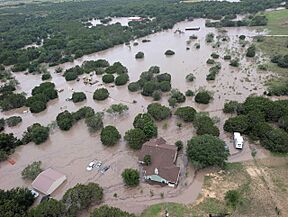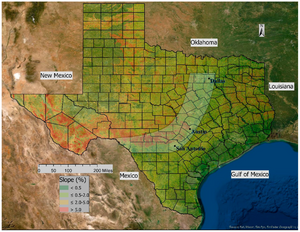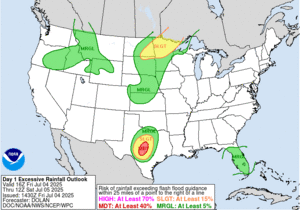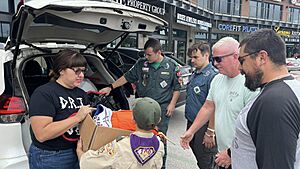July 2025 Central Texas floods facts for kids
|
Clockwise from top: Aerial photo of the heavy flooding near Hunt, Texas, on July 4, 2025. Satellite imagery of the storm responsible for the historic floods. A footbridge damaged by the heavy flooding. Search and rescue operations along the Guadalupe River. Photo of a washed out road and several trees snapped and littered across the ground.
|
|
| Cause | Heavy rains due to a mesoscale convective vortex enhanced with tropical moisture from the remnants of Tropical Storm Barry, and tropical east Pacific remnant moisture |
|---|---|
| Meteorological history | |
| Duration | July 4–7, 2025; July 12–13, 2025 (1 week and 2 days) |
| Flood | |
| Maximum rainfall | 20.33 inches (516.4 mm) |
| Overall effects | |
| Fatalities | Many lives lost |
| Missing | Many people reported missing |
| Areas affected | Texas Hill Country, Central Texas (especially Kerr County), Guadalupe River Watershed |
In July 2025, a powerful and dangerous flood hit the Texas Hill Country in the U.S. state of Texas, especially in Kerr County. The Guadalupe River swelled quickly, causing widespread damage. This flood was caused by very heavy rains from a weather system called a mesoscale convective vortex, which got extra moisture from the remains of Tropical Storm Barry. Many people were affected, and rescue teams worked hard to help everyone.
The heavy rains started on the morning of July 4, causing floods across Central Texas. Weather experts issued several flash flood emergency warnings for cities like Kerrville and Mason. The Guadalupe River rose incredibly fast, jumping about 26 ft (7.9 m) in 45 minutes. In the Hunt area, the river surged an estimated 29 ft (8.8 m). Many people at a summer camp in Hunt were affected. By July 5, more flood warnings were issued for the Lake Travis area. In just a few hours, the Texas Hill Country received as much rain as it usually gets in four months, with some places seeing over 20.33 in (516 mm) of rain. This flood became one of the most serious inland floods in the United States in many years.
Days after the first floods, on July 12, weather forecasters warned of more possible flash flooding in Central Texas. Throughout the night of July 12 and into July 13, new flash flood warnings were issued, including for San Saba County. Because of the risk of more flooding, officials in Kerr County temporarily stopped search operations along the Guadalupe River. Many swift water rescues took place along the Lampasas River near Kempner. The river rose over 30 ft (9.1 m), leading to people being evacuated from an RV park and damaging a boy scout ferry.
After the floods, Texas Governor Greg Abbott and U.S. President Donald Trump declared the area a disaster zone, which helped bring in more aid. Over 2,000 volunteers, along with firefighters and rescue teams from different states and even Mexico, came to help search the Guadalupe River. More than 850 people were rescued from the floodwaters. A U.S. Coast Guard rescue swimmer was praised for helping many people get to safety. There were questions raised about how quickly Kerr County officials responded and whether they had enough warning systems in place. Some reports mentioned that a flood warning system had been discussed before, but wasn't fully put in place due to cost and local support issues. Also, some buildings at Camp Mystic had been removed from special flood risk maps years earlier, which meant less strict rules for building in that area.
Contents
Understanding Why Floods Happen Here
Central Texas, especially the Hill Country, often experiences big floods. This area is sometimes called 'Flash Flood Alley' because it has one of the highest risks for sudden floods in the country. This happens because of its steep hills and dry soil. When it rains heavily, water quickly runs off the land and rushes into rivers. The Guadalupe River and other rivers in this region have flooded many times before, sometimes with serious outcomes. Floods are a serious weather danger in the United States.
After the floods, it was noted that Camp Mystic was in an area known for high flood risk. There were discussions about how some buildings at the camp had been removed from special flood maps by the Federal Emergency Management Agency (FEMA) in the past. This meant that some areas of the camp had fewer strict rules about building, even though they were close to the river. An owner of Camp Mystic had once suggested an automatic alert system for rising water levels, but it was later stopped due to reliability issues. Before the floods, the camp had a written plan for natural disasters, and staff were trained on these plans.
On July 3, 2025, the leftover parts of Tropical Storm Barry combined with other moisture in the atmosphere. This created huge thunderstorms that stayed over Central Texas. These storms brought extremely heavy rains from July 4 to 7, causing the severe floods, especially along the Guadalupe River. Overall, the Texas Hill Country received over 1.8 trillion gallons of rain, which is like four months of rain falling in just a few days.
Warnings and How the Flood Unfolded
On July 3, 2025, the National Weather Service in San Antonio, Texas, issued a flood watch for Kerr County and nearby areas. They warned that 1–3 inches (25–76 mm) of rain was expected, with some spots possibly getting 5–7 inches (130–180 mm). The warning mentioned that heavy rain would likely fall in waves. Later on July 3, the Weather Prediction Center warned that flash flooding was very likely across Central Texas overnight. They expected 2–3 inches (51–76 mm) of rain per hour, with some areas getting over 150 mm in six hours. They said the floods could have 'significant impacts.' By the morning of July 4, their warnings became even stronger, saying 'catastrophic flash flood impacts' were possible.
Many flash flood warnings were issued during the event, some with urgent 'flash flood emergency' messages. The first warning came late on July 3 for Bandera County. By early July 4, warnings were issued for Bandera and Kerr counties. For Hunt and Ingram, a flash flood emergency was declared at 4:03 am, telling people to 'SEEK HIGHER GROUND NOW!' Rain was falling at 2–4 inches (50–100 mm) per hour, on top of 4–10 inches (100–250 mm) that had already fallen. The Guadalupe River at Hunt rose to 21.99 feet (6.70 m) by 4:05 am, a huge jump in just one hour. It kept rising to 37.52 feet (11.44 m), the highest level ever recorded there, before the gauge stopped working. Several summer camps near Hunt, including Camp Mystic, were severely impacted by the flood.
Downstream, in Kerrville, a flash flood emergency was issued at 5:34 am, warning of 'catastrophic' damage. The river there quickly rose from less than two feet (60 cm) to 34.29 feet (10.45 m). In Comfort, the Guadalupe River surged from 3.15 feet (100 cm) to 35.26 feet (10.75 m) in just two hours as a huge wave of water moved downstream. Officials warned of a 'large flood wave' moving down the river. The National Weather Service issued 22 alerts between July 3 and 4. On July 7, more heavy rain was expected, and a new flash flood watch was issued for Central Texas, warning of 2–4 inches (51–102 mm) of rain, with some areas possibly getting 10 inches (250 mm).
After a short break, new heavy rains caused another flash flood emergency on July 13 for Colorado Bend State Park. Radar showed strong thunderstorms bringing more rain. The Lampasas River quickly rose over 30 ft (9 m) in five hours, reaching nearly 32.45 ft (9.89 m) near Kempner.
Impact of the Floods
On the morning of July 4, 6.5 inches (170 mm) of rain fell in just three hours, leading to many water rescues. In Hunt, Texas, where the two branches of the Guadalupe River meet, the river rose 26-foot (7.9 m) in 45 minutes, eventually reaching 37.52 feet (11.44 m). Downstream in Kerrville, the river surged to 21 feet (6.4 m). Further downstream, in Comfort, it reached 29.86 feet (9.10 m). Kerrville declared a disaster declaration on July 4. Overall, some affected areas received 5–11 inches (130–280 mm) of rain.
Flooding continued on July 5, with more flash flood emergencies issued for areas near Lake Travis north of Austin. Another emergency was declared for central Comal County, as the Guadalupe River continued to flood. Some areas, like northwest of Streeter, saw 20.33 inches (516 mm) of rain.
Heroic Rescue Efforts
Over 200 people were rescued on July 4. Rescue teams worked day and night, saving at least 237 people from the floodwaters, including 167 by helicopter from trees and roofs. A U.S. Coast Guard rescue swimmer was praised for helping many people get to safety. Communication was difficult due to power outages. By July 8, over 440 people had been rescued, and authorities had searched 26 miles (42 km) of the river. More than 2,000 volunteers joined the emergency efforts in Kerr County.
Many groups from over twelve U.S. states and agencies, plus a team from Mexico, joined the search and rescue. Firefighters from Acuña, Mexico, brought search and rescue dogs to help along the Guadalupe River. On July 7, California Governor Gavin Newsom sent skilled Urban Search and Rescue teams to Texas, working with FEMA. These teams had experience from big disasters like Hurricane Katrina and the September 11 attacks. More rescue team members arrived the next day.
On July 8, twenty-two Arkansas National Guard members, including pilots, helped transport rescue teams. Colorado Task Force One, with 48 members and four search dogs, also joined the effort. Louisiana Governor Jeff Landry sent fourteen Swift Water Rescue experts on July 7. On July 9, NASA used two aircraft to help with the recovery, working with the Texas Division of Emergency Management, FEMA, and charities like Save the Children and GiveDirectly.
North Dakota Governor Kelly Armstrong sent an MQ-9 Reaper drone to help find survivors and assess damage from above. On July 11, Ohio Task Force One sent three members and two search dogs to help. Ohio Governor Mike DeWine also sent the Ohio State Highway Patrol and a team from the Ohio Department of Natural Resources. Many active and former Navy SEALS also volunteered to help with the search and recovery.
Minnesota Governor Tim Walz sent specialized K9 units to help. Arizona Task Force One sent a team of 49, including search dogs, medical staff, and engineers, along with vehicles and boats. Eight members of the Swiftwater Rescue Team from Virginia Beach also arrived. Nevada Task Force One sent a team of 47 with four K9 units. On July 14, Tennessee Task Force One sent four people and three search dogs to Kerr County, and Tennessee Task Force Two also deployed an Urban Rescue & Rescue team to help.
On July 13, rescue operations continued in counties like Lampasas and San Saba, as the Lampasas River rose over 30 ft (9.1 m). Officials asked people who weren't trained to stay away from rescue areas for safety reasons. They also noted that unauthorized drones and too many sightseers made rescue work harder. On July 7, an illegal drone crashed into a rescue helicopter, damaging it. On July 13, search operations were paused because of new flood threats.
Key Dates of the Flood Event
- July 3
- Weather Service issues early flood alerts for Central Texas.
- July 4
- Extremely heavy rain causes severe flash flooding in the Texas Hill Country.
- The Guadalupe River rises very quickly, setting a new record high.
- Urgent Flash Flood Emergencies are declared for several counties.
- Summer camps, including Camp Mystic, are severely impacted.
- Many people are reported missing or affected.
- July 5
- Flooding continues in areas like Lake Travis.
- More people are reported missing.
- July 6
- Discussions begin about the effectiveness of flood alert systems.
- July 7
- Drones and National Guard units from many states join rescue efforts.
- July 8
- Over 440 people are rescued. Aid arrives from various states and organizations.
- July 9
- More rescue teams and drones are deployed.
- July 10
- Disaster Recovery Centers open to help affected families.
- July 11
- Search efforts continue. President Donald Trump visits the affected areas.
- July 12
- Discussions continue about warning systems. Relief efforts increase with help from many organizations.
- July 13
- New heavy rains cause more flooding, pausing some search and rescue efforts.
- More rescues and evacuations are carried out.
People Affected by the Flood
The July 2025 floods tragically affected many people. While rescue teams worked tirelessly, many individuals sadly lost their lives, and others were reported missing. The areas most impacted included Kerr County, Travis County, and Kendall County. Summer camps, such as Camp Mystic, were severely hit, and many campers and staff were affected. Search efforts continued for days to find everyone reported missing.
Community Support and Recovery
After the floods, many groups stepped up to help. The grocery chain H-E-B sent mobile kitchens and donated $5 million for relief. All Hands and Hearts worked with Airbnb to provide temporary housing for rescue workers and families affected by the floods. The World Central Kitchen team also provided food and water to those in need, including first responders.
Samaritan's Purse sent a disaster relief unit with tools and supplies, and volunteers helped families recover. Operation Airdrop used planes to deliver supplies to hard-to-reach areas. Firefighters from Acuña, Mexico, also came to help. Companies like T-Mobile, Walmart, and Sam's Club donated hundreds of thousands of dollars to support relief efforts. Walmart also provided free meals, laundry services, and supplies through partners like the American Red Cross and The Salvation Army.
In Kerrville, a large memorial was created along the Guadalupe River, filled with flowers and signs to remember those affected. On July 11, 300 people gathered for a vigil, sharing stories and offering comfort. Basketball teams like the Houston Rockets, Dallas Mavericks, and San Antonio Spurs helped by creating 'Texas Strong' t-shirts to raise money for flood relief. A local business, Signarama, also made 'Hill Country Strong' signs, donating the money raised to The Community Foundation in Kerrville. In total, The Community Foundation raised $30 million for flood relief.
See also
 In Spanish: Inundaciones de Texas de 2025 para niños
In Spanish: Inundaciones de Texas de 2025 para niños
- Floods in the United States (2000–present)
- List of deadliest floods
- 1921 San Antonio floods – the deadliest freshwater flooding event on record in Texas
- 1987 Comfort flood









